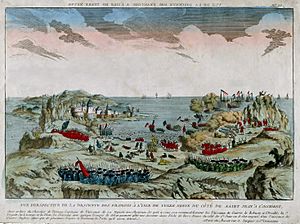Battle of Signal Hill facts for kids
Quick facts for kids Battle of Signal Hill |
|||||||
|---|---|---|---|---|---|---|---|
| Part of the Seven Years' War | |||||||
 Vue de la descente a Terre Neuve par le chevalier de Ternay en 1762, Unknown artist |
|||||||
|
|||||||
| Belligerents | |||||||
| Commanders and leaders | |||||||
| Strength | |||||||
| 1,559 | 800 | ||||||
| Casualties and losses | |||||||
| 24 killed and wounded | 40 killed and wounded | ||||||
The Battle of Signal Hill happened on September 15, 1762. It was the very last battle of the Seven Years' War in North America. During this battle, a British army led by Lieutenant Colonel William Amherst took back St. John's. The French had captured St. John's earlier that year in a surprise attack.
Contents
Why the Battle Happened
By 1762, France and Britain had been fighting for seven years. Both countries were starting to think about making peace. Britain had blocked the French coast for a long time. This hurt the French economy. It also stopped the French navy from helping their colonies around the world. Many French colonies were captured because of this.
France wanted to rebuild its navy during peacetime. They believed they needed access to the fishing areas near Newfoundland. So, they planned to capture the island. This was done before peace talks began. In May 1762, a small French force left Brest. It was led by the Chevalier de Ternay. They managed to get past the British blockade and sailed into the Atlantic.
French Takeover of St. John's
On June 27, 1762, the French, led by Comte d'Haussonville, made the British in St. John's surrender. In the weeks that followed, d'Haussonville followed orders from the Chevalier de Ternay. He made the French position stronger in Newfoundland.
His defense plan included several small outposts. These posts had cannons and were set up around Signal Hill. Signal Hill was a very important spot. It overlooked the whole area. On September 13, 1762, the British landed at Torbay. This was a few miles north of St. John's. Ternay and Haussonville could not stop them. To slow down the British, they sent a group of soldiers to guard the top of Signal Hill.
Why Signal Hill Was Important
St. John's is the most easterly city in the Americas. This made it a key place for ships from Europe to stop. Ships could get ready there for longer journeys inland. The French took this valuable land from the British. The British then used a similar plan to win it back.
Besides its port advantages, St. John's had many natural resources. It had a huge fishing industry. By 1540, Spanish and Portuguese ships came just to fish. The land also had many fir and spruce trees. These trees were used for ships and sometimes for food or medicine.
Signal Hill was used to defend St. John's throughout the 1700s. It is on the Atlantic coast. It sits next to the entrance of St. John's harbor. During the battle, the sea was the main way to travel. So, soldiers on Signal Hill could see enemy ships from far away. Also, ships had to pass Signal Hill to enter St. John's by sea. This made it hard for enemy warships to attack the settlement.
The Battle Begins
On August 26, British warships reached Halifax Harbour. These ships were sent by Amherst and led by Captain Campbell. They hoped to take back St. John's. They left for sea on September 1. This was three days later than planned because of bad winds.
These warships reached Louisbourg on September 5. They left on September 7. Campbell's fleet met Lord Colvill's fleet on September 11. This was near the southern coast of St. John's. On September 12, the fleets landed at Torbay. This was a few miles north of St. John's. They captured three prisoners there.
The French commanders, Count D'Haussonville and Bellecombe, could not stop the British landing at Torbay. So, they sent a group of soldiers to guard Signal Hill. They saw it as an important defense point. Early on September 15, British troops climbed the hill where the French were. The French were completely surprised. The fight was short but deadly. The French commander, Guillaume de Bellecombe, was badly hurt. On the British side, a bullet hit the legs of one of Amherst's officers, MacDonell. The British attacked about 295 French soldiers. The remaining French soldiers, about 600, retreated to Fort William.
After the Battle
After the battle, Signal Hill was controlled by the British. They now had a strong position. The British brought many cannons to their spot from Torbay. They started building places to fire cannons at the fort. Three days later, the French soldiers in St. John's surrendered. There were just over 700 French regular soldiers.
See also
 In Spanish: Batalla de Signal Hill para niños
In Spanish: Batalla de Signal Hill para niños

